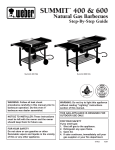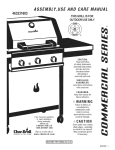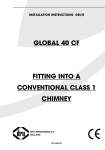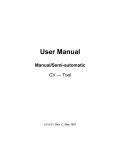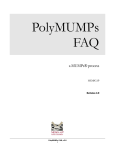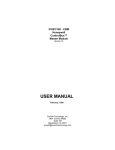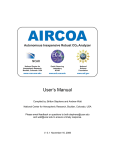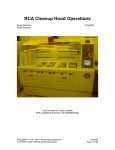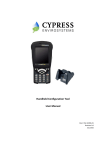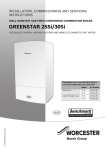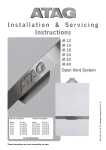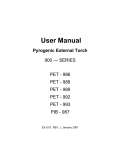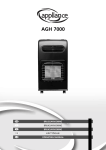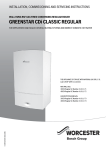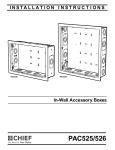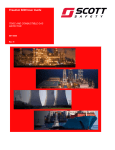Download Gas cabinet Reference Manual
Transcript
Gas cabinet Reference Manual Tempress® Systems, Inc. Gas cabinet manual M330_01 January 2004 This page intentionally left blank TABLE OF CONTENTS Table of contents 1. Introduction .......................................................................1-1 1.1 Scope of the manual ................................................................. 1-1 1.2 Overview................................................................................... 1-1 2. Gas System........................................................................2-1 2.1 Gassystem parts ....................................................................... 2-3 2.2 Electronics .............................................................................. 2-14 2.3 Processes ............................................................................... 2-14 3. Installation .........................................................................3-1 3.1 Unpacking................................................................................. 3-1 3.2 Inspection ................................................................................. 3-2 3.3 The gas cabinet ........................................................................ 3-2 4. Start Up ..............................................................................4-1 4.1 Introduction ............................................................................... 4-1 4.2 Prerequisites............................................................................. 4-1 4.3 Gas Cabinet start up ................................................................. 4-1 5. Maintenance.......................................................................5-1 5.1 Introduction ............................................................................... 5-1 5.2 Leak-checks.............................................................................. 5-1 5.2.1 Helium Leak check .................................................... 5-1 5.2.2 Pressure Leak-check ................................................. 5-2 5.3 Disassembly and cleaning of MFC’s ......................................... 5-2 5.4 Disassembly and Cleaning of all flowmeters............................. 5-2 5.5 Preventive maintenance Gassystem......................................... 5-3 5.6 Preventive maintenance processes .......................................... 5-5 6. Trouble shooting ...............................................................6-1 GAS CABINET REFERENCE MANUAL III LIST OF FIGURES List of figures Figure 1-1 Tempress L-shaped Gascabinet ............................................ 1-1 Figure 2-1 Source gas pressure adjustment ........................................... 2-3 Figure 2-2 LPCVD Gaspanel and components ....................................... 2-4 Figure 2-3 Mass Flow Controller example............................................... 2-6 Figure 2-4 Mini and micro inline gas filter................................................ 2-7 Figure 2-5 Flowmeter .............................................................................. 2-7 Figure 2-6 SMC digital pressure switch................................................... 2-8 Figure 2-7 Photohelic with high and low alarm limits............................... 2-8 Figure 2-8 Schumacher ATCS bubbler system ....................................... 2-9 Figure 2-9 Coldtrap (small design) ........................................................ 2-12 Figure 2-10 Cooling Spiral tube with Ammonium chloride (NH4Cl) deposit213 GAS CABINET REFERENCE MANUAL IV INTRODUCTION 1.Introduction 1.1 Scope of the manual This manual explains how to install, adjust or maintain the Tempress Systems Inc. gascabinet, including its gassystem and all peripheral equipment and parts descriptions. For technical instructions and descriptions concerning the DPC refer to the DPC reference manual (M410.00). Before starting up, installing, operating and/or maintaining the complete gascabinet it is mandatory to read this manual first. 1.2 Overview The gascabinet is part of the Tempress Systems Inc. diffusion furnace. It contains all process gas facilities as well as the Digital Process Controller (DPC) and peripheral equipment. The standard L-shape cabinet can be replaced by a backmounted unted cabinet in case of limited space. Normally the gascabinet will be placed in the grey-room. Place for Peripheral equipment Process gas facilities DPC Figure 1-1 Tempress L-shaped Gascabinet The Tempress Systems Gas cabinets are designed for easy access to all components and shielded with Plexiglas doors, see Figure 1-1. The cabinets are made of heavy gauge steel with a polyurethane finish. The gas cabinet is exhausted through the full height of the cabinet. The space saving vertically mounted gassystems offer additional space for accessory units, such as external torch and bubbler systems, and easy tube exchange from the rear. The flexible gas cabinet design, in combination with the small footprint furnaces, makes the Tempress Systems furnaces adaptable to most cleanroom layouts. GAS CABINET REFERENCE MANUAL 1-1 GAS SYSTEM 2. Gas System The gassystem is defined as the complete gas supply. It includes preplumbing, gaspanels and electronic components. The gassystems provide the desired flows of (a mixture of) gasses required for the different kind of processes. Each process has its own gassystem. The gas cabinet of a furnace can contain any of the following components, which will be described in the following sections. • Pressure Gauges • Pressure Regulators • Gaspanels Manual shut-off valve Pneumatic valve Fine metering valve Check valve Mass Flow Controllers Mini and Micro Inline Gas Filters Flowmeters GAS CABINET REFERENCE MANUAL 2-1 GAS SYSTEM Digital pressure switch • Bubbler systems • External torches • Coldtrap • Vacuum pumps system • Interconnection Board • DPC GAS CABINET REFERENCE MANUAL 2-2 GAS SYSTEM 2.1 Gassystem parts Pressure Gauges The pressure gauge is used for readout of the process gas pressure before the gas is distributed to the gaspanels. It is designed with safety features to minimize injury to personnel and damage to property in the event of a gauge failure. The gauges are mounted above the gassystems at the front of the gascabinet. Pressure Gauge Pressure Regulator Figure 2-1 Source gas pressure adjustment Pressure Regulators Each process gas has its own regulator to reduce the gassource pressure and adjust the correct pressure to the gassystem. The pressure regulators are part of the pre-plumbing and are located above the gaspanels, see Figure 2-1. GAS CABINET REFERENCE MANUAL 2-3 GAS SYSTEM Gaspanels Digital pressure switch Manual shut-off valve Pneumatic valve Mass Flow Controller Inline gasfilter Figure 2-2 LPCVD Gaspanel and components The design of a gaspanel is dedicated to a particular process (refer to section 2.3) and must be used accordingly. It contains all necessary components to distribute the required gasflows in a safe and reliable manner. The gassystem including its gaspanel is vertically mounted by default. A vertically mounted gaspanel allows disassembling of a process tube from the rear (greyroom). Note: Vertical gaspanels are always orbital welded. Four gaspanelmodels are defined as default concepts. See Table 2-1 for details. Table 2-1 Gaspanel models Model Nr. 1 2 3 4 (Tempress Standard) Piping SS 316L SS 316 L SS 316L SS 316L Welding Heli-arc Heli-arc Heli-arc Orbital/Butt weld Flow control Flowmeter Mass Flow Controller Mass Flow Controller Mass Flow Controller Couplings Swagelok Swagelok VCR VCR Millipore Millipore Filters Valves Skinner/Solenoid GAS CABINET REFERENCE MANUAL Skinner/Solenoid Air or N2 Air or N2 operated Nupro operated Nupro 2-4 GAS SYSTEM Power supply 115/220/240 Volt, 50/60 Hz Build-in Graphic display Separate Separate Separate Separate Flow screen TSCII TSCII or Touchscreen TSCII or Touchscreen Process Control Optional Digital Process Controller Digital Process Controller Digital Process Digital Process Controller Controller Model series 1: general features • Very reliable and simple systems. Complete self-contained with flow schematic and LED display showing actuation of the solenoid valves. • Additional safety systems located at the interconnection board include: a safety board, a pressure interface board and a High/Low limit board. Optional items: • Electronic Interconnection board for fully automatic control with DPC. • Remote Control by Touchscreen or TSC-2 with graphic display, mounted remotely from the gassystem. Model series 2: general features • Gastray construction with swing-out, swing-down doors for easy access to all components. • Electronic hardware is located in a separate compartment in the gascabinet. • The power supply is a separate unit. • Graphic Display is delivered as a separate unit with flatcable connections or incorporated in Touch Screen. Model series 3: The same as series 2, however for systems where higher performance concerning contamination is required, VCR instead of Swagelok and point of use filters are used. Model series 4 (Tempress standard): These systems meet the highest requirements concerning low contamination and serviceability. All connections are orbital/butt welded. Electronic hardware is build into a separate compartment in the gas cabinet. Testing in the factory All gaspanels are functionally tested and helium leak checked. GAS CABINET REFERENCE MANUAL 2-5 GAS SYSTEM Manual shut-off valve With the Manual shut-off valve (Figure 2-2) individual gaslines can be closed. Typically only closed during maintenance activities, otherwise always open. Ball valves should only be used fully open or fully closed. Pneumatic valve On the gaspanels model 3 and 4 only pneumatic controlled valves are used (see Figure 2-2). Electronic controlled valves could introduce risks of explosion or fire in a gascabinet with reactive gas environments and are therefore not used. On request pneumatic valves can be operated with N2 instead of air. Fine metering valve A Fine Metering Valve (FMV) is a hardware component that is used for LPCVD processes to supply an adjustable N2 purge flow for standby condition and reduction of the pressure overshoot from the pressure control valve. Check valve Check valves are used in atmospheric processes to avoid backstreaming of blend gases. They are normally located where Nitrogen and/or Oxygen blend with other process gasses. The check valve allows the gasflow in only one direction to avoid backflow of the mixed process gas. Mass Flow Controllers A Mass Flow Controller (Figure 2-3)accurately measures and controls gasflows. The heart of the MFC control system is the flowsensor that contains 2 temperature sensor and 1 heating element. A power supply directs heat to the midpoint of the sensor tube. On the same tube equidistant upstream and downstream of the heat input are resistance temperature measuring elements. With no flow the heat reaching each temperature element is equal. With increasing flow the flowing stream carries an increasing amount of heat towards the downstream element and away from the upstream element. An increasing temperature difference develops between the two elements. This difference is proportional to the amount of gas. Electronics Control valve Figure 2-3 Mass Flow Controller (example) GAS CABINET REFERENCE MANUAL 2-6 GAS SYSTEM Mini and Micro Inline Gas Filters Mini and micro inline gas filters are designed for flow rates up to 100 slm (3.5 scfm) and are usually installed in bulkhead areas. Mini filters are normally used in the pre-plumbing and micro filters on gaspanels. Teflon® PTFE membrane on a Teflon PFA support eliminates downstream shedding and provides full compatibility with all process gases. Functionally gas passes through the inlet around the filter core through the membrane. Inlet gas is isolated from the purified outlet gas by a hermetic seal between the filter element and the stainless steel shell. Figure 2-4 Mini and micro inline gas filter Flowmeters The flowmeters are variable area flowrate indicating meters used in low cost systems. The basic elements are a tapered glass metering tube and a metering float. Features include quick and simple removal or installation of the tube and float while the meter remains in the process piping. After the flowmeter has been installed in the flowsystem it is ready for operation. A built-in needle control valve controls the flow through the flowmeter. These control valves are designed for fine control. Excessive tightening may damage the valve seat and limit its effectiveness as a control valve. If tight shut-off is required, it is recommended that a separate shutoff valve be installed in the line immediately before the flowmeters. Figure 2-5 Flowmeter GAS CABINET REFERENCE MANUAL 2-7 GAS SYSTEM Digital pressure switch The SMC Digital Pressure Switch is a wide pressure range device with High and Low alarm limits. It is used to monitor N2 supply pressure and to activate the (optional) LPCVD baratron isolation valve. The diaphragm design prevents the sensor to directly contact fluid media. The calibration data is stored in an EEPROM. The EEPROM is rated to keep its memory for 100,000 hours without having power supplied. Figure 2-6 SMC digital pressure switch Photohelic Figure 2-7 Photohelic with high and low alarm limits The photohelic is normally mounted above the gaspanels at the front of the gas cabinet. It is a repeatable differential pressure switch with an analog pressure gauge. Switch setting can be adjusted with large external knobs on the gauge face. The gauge reading is unaffected by the switch operation – it will indicate accurately even if power is interrupted. This model provides both low and high limit control. GAS CABINET REFERENCE MANUAL 2-8 GAS SYSTEM Bubbler systems Bubbler systems are used to deliver liquid sources such as POCl3, TMB, TransLC® or DCE, to atmospheric or LPCVD process tubes. Carrier gas pick-up can be used for atmospheric tubes while direct evaporation is used for LPCVD tubes. Any brand and type of bubbler system can be used to match customer needs such as Schumachers ATCS or Komatsus etc. Bubbler systems must be designed for the particular chemical and application. Schumacher ATCS bubbler system The Schumacher ATCS Temperature Controller is a micro-processor based temperature control system for accurate and stable temperature control of liquid source chemicals. It consists of a Base Unit, a Source Unit and a Control Unit. Figure 2-8 Schumacher ATCS bubbler system The Bubbler containing the chemical is placed in the Source Unit. The Source Unit allows for easy access, installation, maintenance, and replacement of the Bubblers. The Source Unit is equipped with a power-connecting socket for connection to the Base Unit, a four segment level sensor and window to allow visual inspection of the Bubbler level. The Source Unit can be removed from the Base Unit and be placed in an exhaust hood for added safety during replacement of Bubblers. The Base Unit accommodates the Source Unit and provides the interface between the Source Unit and the Control Unit. The Base Units are equipped with coolers, heaters and a temperature-sensing probe. The heater offsets the effect of the cooler to attain the temperature within the specified range. A multiple conductor cable connects the Base Unit to the Control Unit, providing current paths for the cooler, heater, temperature probe and level sense. The push button on the front illuminates the back light to view the liquid level through the window on the Source Unit. The Control Unit provides the electrical power and necessary current control to maintain a selected temperature and, therefore, constant vapor pressure within the Bubbler. The front panel controls consist of an ON/OFF power switch, an audio defeat, and mode selection push button. The Control Unit furnishes a regulated voltage for the cooler. Voltage pulses at varying rates to the heater. Thus, an average power level is established in the Base Unit that GAS CABINET REFERENCE MANUAL 2-9 GAS SYSTEM will maintain the temperature of the source chemical in the Bubbler within ±0.20C of the selected temperature. Schumacher ATCS bubbler system include standard temperature range (POCl3, TMB), high temperature range (TEOS) and TransLC specific models. GAS CABINET REFERENCE MANUAL 2-10 GAS SYSTEM Trans-LC® bubbler system The Trans 1,2 Dichloroethylene (Trans-LC®) is an Schumacher ozon-safe liquid chlorine source in silicon oxidation and tube cleaning. For more information about the properties and applications of TransLC® see the process manual. The Trans-LC bubbler system consists of the following components: • Trans-LC System • Source System • Base System • Control Unit The ATCS-TLC is modified to fit the Trans-LC properties. The Source unit (ATCS) is equipped with an over temperature cut-out switch in the TLC model. The temperature setpoint is hardware limited to a range of 100C to 220C. The temperature alarm window is opened from the standard +20 C to + 50 C. The Schumacher Smart Probe is included. This probe system prevents the Bubbler from being installed in the incorrect orientation that may interfere with the level sensing system. The probe system also generates a temperature alarm and prevents the heater from operating if the temperature probe is not fully inserted through the front insulation cover hole and into the Bubbler. Potential spark sources are removed from both the Source Unit and Basic Unit. These units are suitable for use in an area where Trans-LC vapors may be present. The Control Unit does not have spark or ignition sources removed and therefore must be located in an area where explosive vapors are not present. WARNING: EXPLOSION HAZARD. Spark or ignition sources are present in the Control Unit. The user must ensure that the Control Unit is located in an area where explosive vapors are not present. Under no circumstances should electrical connectors be connected or disconnected while the equipment is energized. External torches The Tempress Standard External Torch is compromised of a water-cooled stainless steel shell, which contains a quartz balloon (in which the steam will be produced), a mixer-assy, a ball-joint and a heating element. It generates high purity steam, without detrimental effects on the temperature profile of the furnace. The location of the external torch is in the gassource cabinet. A thermocouple is inserted in the inner tube of the mixer assy. O2 and H2 are fed separately into the mixer-assy and are heated above 750 0C. When the gases are mixing in the quartz balloon, the H2 ignites spontaneously and water vapour is produced. The torch temperature is regulated by a digital temperature controller. For more detailed information see the enclosed “External Torch Manual”. GAS CABINET REFERENCE MANUAL 2-11 GAS SYSTEM A Persys Pyrogenic External Torch can be used only on customers request. For more information about the Persys Pyrogenic External Torch, refer to its user manual, see Vendor documentation (M540.00). Coldtrap A coldtrap is necessary whenever a process produces condensable waste products, which can contaminate vacuumlines and potentially cause particle problems. An example of such a process is silicon-nitride (Si3N4) from SiH2Cl2 and NH3. The gasses should cool down on a cold surface so it is important to have that surface as close to the entrance of the cold-trap as possible. A cooling water temperature of 15oC is required for an optimized operation. Specifically for the nitride deposition process two different forms of waste product can be found in the coldtrap. A white powder form and a glassy solid form. The glassy form is what occurs as the gasses are shock-cooled on any cold surface. This is the form that is wanted on the coldtrap. The white powder form occurs from slow cooling and condensation in the gasphase, and will hardly be trapped by the coldtrap. Instead, most of it will be found at the inlet filter and exhaust of the dry pump, or in the oil of a wet pump. A short connection between tube and coldtrap should decrease the amount of powder form and increase the glassy form. Special precautions are required to prevent O-ring damage or melting. A coldtrap usually consists of two parts: the outer housing and the inner cooling element. Waste products of the deposition process are rapidly cooled off on the inner element and removed from the gas stream. Figure 2-9 Coldtrap (small design) Figure 2-10 shows a spiral tube with the incoming cooling line in the center, spiraling down to the bottom. Some white NH4Cl deposit is visible which can be removed by rinsing into hot water. GAS CABINET REFERENCE MANUAL 2-12 GAS SYSTEM Figure 2-10 Cooling Spiral tube with Ammonium chloride (NH4Cl) deposit Frequent cleaning is required for process operation and is highly dependent on the customers situation. A starting cleaning interval is 2 microns of accumulative nitride deposition on the wafers. Further determination needs to be done by the customer. Because the waste product of the nitride process is water-soluble the deposit can be removed by rinsing with water. Hot water will speed up this cleaning procedure. Rinsing with isopropanol afterwards will facilitate blow-drying before remounting. Cooling water is connected with QuickConnects. Dirt or corrosion occuring inside the quickconnect might hamper the connection. Forced air-drying with compressed air is usually sufficient to clear the obstruction. Vacuum pumps system Vacuum pump systems are used for LPCVD processes to create under-pressure in de process tube. The current industry standard is dry pump, although wet (oil lubricated) pumps are still widely used. Refer to the vendor documentation (M540.00) for detailed technical information. GAS CABINET REFERENCE MANUAL 2-13 GAS SYSTEM 2.2 Electronics Interconnection Boards The digital and analog interconnection boards for the gassystem are used as an interconnection between the DPC, the safety boards and the gaspanel. The safety boards allow the opening of valves for specific (dangerous) gases only if all safe conditions are satisfied. For a complete description of the interconnection and safety boards, see the DPC Reference manual. DPC The Digital Process Controller together with the Digital Temperature Controller (DTC) forms the heart of the system control. For detailed information refer to the DPC reference manual (M410.00) Safety board A safety board is used to check the safety conditions when using hydrogen and oxygen in a Tempress external torch. It is used as a hardware protection. This safety board works only in combination with the Tempress DPC control system. It is not used in this configuration as a “stand-alone” unit. Pressure interface board A pressure interface board is used in Low Pressure Chemical Vapour Deposition (LPCVD) gassystems as safety component for the right gaspressure. The process gaspressure will be compared with a safety setpoint of default 1.4 Torr. Specific valves can only be opened if the process pressure is below this safety setpoint. High/Low limit board A high/low limit board is used as a safety component to prevent specific valves to be opened if a required gasflow is out of range. 2.3 Processes A variety of guaranteed processes are available on the Tempress Diffusion systems, including: Atmospheric • Anneal • Dry Oxidation (with or without TransLC cleaning) • Wet Oxidation (with or without TransLC cleaning) • POCl3 GAS CABINET REFERENCE MANUAL 2-14 GAS SYSTEM Low pressure • Ramped Poly • Flat Poly • Nitride • TEOS • LTO • Ta2O5 Because of the flexibility of the Tempress Systems Inc. systems variations on these processes are available as well, such as doped or low stress versions. GAS CABINET REFERENCE MANUAL 2-15 INSTALLATION 3.Installation 3.1 Unpacking • Inspect the packing materials before unpacking the gas cabinet and all its accessories. If there is any visible damage caused by the transport, the carrier must be contacted to inspect the damage before unpacking. • If there is any visible damage Tempress Systems Inc. must be informed within 24 hours; • Unpack the boxes one by one; • Release and remove equipment wrappings. 2 layers of sheets are covering the gas cabinet and its accessories. The first layer must be removed outside the cleanroom, the second layer must be removed inside the cleanroom. • Check the contents of the boxes with the collo contents list; • Depending on the type of packing materials is being used; a final de-dusting must be done before it is put into position. Although the system has been cleaned before shipping the additional cleaning is highly recommended. • Lift or pull the wrappings away from all stainless steel surfaces. Do not drag packing materials across the equipment surfaces as this may cause damage to its surface. • A forklift with a minimum capacity of 1500 kg has to be available to move the gas cabinet its final position. GAS CABINET REFERENCE MANUAL 3-1 INSTALLATION 3.2 Inspection Check for any parts that may have loosened or become free during transit (especially the electrical connections) and check all components for damage. 3.3 The gas cabinet • Move or replace the gas cabinet to its final position. • Align the gas cabinet with respect to the furnace. • Place a spirit level on top of the gas cabinet. The gas cabinet can be levelled by the adjustable feet. • Install all facilities as defined on the outline drawing and verify that they comply with the labelling. • Do not turn on any of the services connected without the presence of a qualified engineer from Tempress, unless written permission is gained from Tempress. • The Tempress-engineer will check final alignments and facility functionality. • Install the exhaust, with a flowrate as defined on the outline drawing. • The customer should install all external connections of the gaslines, compressed air and cooling water to the bulkheads. • All gaslines should be helium leak checked by the customer prior to operation (10-8 cc/min) • A qualified Tempress engineer will do all internal connections. • Install the socket-joint and clamp it on the ball-joint of the tube. Make sure the installation of the furnace has been finished and the tube is placed. GAS CABINET REFERENCE MANUAL 3-2 START UP 4.Start Up 4.1 Introduction After the gas cabinet is installed and connected correctly, start-up can begin. Valve operation and gasflows (including pressure control for LPCVD) will be controlled by the DPC. In case of emergency or system failure, all system power can be switched off by the EMOswitch, forcing all NC valves to be closed and gaslines to be shut off. See the outline drawing for the exact locations of the EMO-switch on the gascabinet. 4.2 Prerequisites First the furnace, loadstation, gascabinet and powercabinet installation must have been completed. Second, the start-up procedure of the furnace as described in the “Diffusion Furnace” manual, chapter 5.0 (Start-Up) must be completed. 4.3 Gas Cabinet start up For each gasline: • • • • • • • • • • Check connections Make sure gaslines are connected to the processtube Make sure the tube is sealed properly (boat in) Close door Close MFC’s Close valves Close handvalves Close regulators Close facility gas supply Close gas bottle (depending on customers facilities) Atmospheric • • • • Open facility gassupply Set regulator to 30 psi N2 and 20 – 25 psi H2, O2 Open handvalves on all tube levels Close facility gas supply GAS CABINET REFERENCE MANUAL LPCVD • • • • • Start the pump Evacuate the tube Open process valve (manifold) Pump until base pressure is reached Maximize MFC setpoint 4-1 START UP • • • • • • Mark pressure reading Leave gassystem pressurized for at least 12 hours Mark pressure reading. Any drop in pressure indicates a gas leak. Use suitable gasleak detector (such as Snoopy or electronic) to trace any leak When no pressure drop is detected open the facility gas supply. The gassystem is ready for use. • • • • • • • • • • • • • • • • • • • • • • • • • • • • • GAS CABINET REFERENCE MANUAL Pump until base pressure Open handvalve Pump until base pressure Open regulator fully Pump until base pressure Open facility gas supply slowly Pump until base pressure Leakcheak max 20 mtor/min right up to the bottle Open N2 purge at gas bottle cabinet briefly. Pressure should not exceed the safety setpoint of 1.4 torr measured at the tube. Pump until base pressure Repeat N2 purge/ Pump cycle 20 times. Leakcheck max. 20 mtor/min Close facility gas supply Close regulator Close handvalve Close MFC Close process valve Slowly open the gas bottle Slowly open facility gas supply Slowly open the regulator Set pressure at 20 psi. If gaslines are shared with other tubes use 30 psi for N2 and 20-25 psi for O2 Slowly open the handvalve at all applicable tube levels Close facility gas supply Mark pressure reading Leave gassystem pressurized for at least 12 hours Mark pressure reading. Any drop in pressure indicates a gasleak. Use suitable gas leak detector (such as Snoopy or electronic) to trace any leak When no pressure drop is detected open the facility gas supply. The gassystem is ready for use. 4-2 MAINTENANCE 5.Maintenance 5.1 Introduction Maintenance for the gascabinet and its components is limited due to the use of high quality components and high purity elements. Routine checks include pressure gauge readings every day and inline filter replacement every year. 5.2 Leak-checks Whenever a component in the gasline (either the preplumbing or gaspanel) is replaced a full leakcheck is required. Two different kinds of leak-checks are possible. There are a helium- and a pressure leakcheck. 5.2.1 Helium Leak check A Helium leak check is used to test the integrity of the components or complete gasline. • Connect the leaktester on a gas-inlet; • Open the pressure regulator fully to maximum; • Open the handvalve at tube level; • Open the MFC (this must be done by the DPC, for more information, look at the manual of the DPC); • Open all valves in the gassystem (this must also be done by the DPC); • Leak check may now begin; • If no leak is found, repeat steps, mentioned above, in reversed and opposed order. However, if a leak has been found, tighten/repair the relating nut/coupling (etc.). NOTE Leak must be below 1 * 10 -8 atm. cm 3/sec. NOTE If a checkvalve is present then a leak-check must be done at both sides of this valve. GAS CABINET REFERENCE MANUAL 5-1 MAINTENANCE 5.2.2 Pressure Leak-check A pressure test is used to test all connections at supply pressures see Gas Cabinet start up 4.3. 5.3 Disassembly and cleaning of MFC’s MFC’s are complex components, which require specialist tools and skills. It is recommendable to return the MFC to the supplier for cleaning and/or repair (make sure to include the proper contamination reports). Evacuate upstream and downstream of the MFC in case it is inside a gasline for toxic or flammable gases. 5.4 Disassembly and Cleaning of all flowmeters The metering tube, float and float stops may be removed as an assembly for cleaning or replacement, without removing the meter from the line. To disassemble, use the following procedure: 1. Remove the plastic safety shield. 2. Loosen the seal spindle by turning it counter clockwise with a 4 mm hex wrench. The tube must be pushed into the direction of the seal spindle and may now be canted out of the meter housing. If it is desired to clean the metering tube, float and float stops as an assembly (using a solvent or ultrasonic cleaner) only the above two-steps are required. However, if complete disassembly is required, use the remaining steps. 3. Using a small hook, remove both Teflon float stops from the metering tube and remove the float. Be careful not to chip tube ends. 4. Packing seats and packing inserts now may be removed. 5. With the metering tube out, the seal spindle may be rotated clockwise for removal. It should not be necessary to remove the seal spindle unless the 0-ring that seals the spindle requires replacement. The O-ring may be used as long as it is not torn or distorted. 6. The needle control valve assembly may be removed by turning the valve body counter clockwise. The valve seat, stem and packing then may be carefully removed from the valve body for cleaning or replacement. 7. The metering tube, made of Borosilicate glass, may be cleaned with any solvent that does not attack glass. Reassembly Procedure 1. Use the reverse of steps 1 through 7 of the disassembly procedure to reassemble the meter. 2. When replacing the packing seats in the flowmeter body be sure the packing inserts are approximately 1,5 mm above the top of the packing seat. Also be certain the tube seats firmly on the packing seats and does not overlap onto the end block. 3. The seal spindle serves to radial compress the tube seat gasket and exert a uniform pressure on the metering tube to prevent any possibility of leakage. Do not over tighten the seal spindle. GAS CABINET REFERENCE MANUAL 5-2 MAINTENANCE 5.5 Preventive maintenance Gassystem Daily maintenance: Check gas pressures approx. 25 psi. Check for visible signs of leakage (liquid supply lines) Check Touchscreen and/or TSC system for any alarms. Check gasflows of MFC’s take in account that certain hardware interlocks are implemented in the gassystem. ------------------------------------------------------------------------------------------------------- Weekly maintenance For Metal Alloy tubes the Hydrogen filaments should be visually checked. If applicable check the liquid source level If applicable check the External Torch on flame shape (there should be no red color in the flame “tip burning”, and check for condensation. ------------------------------------------------------------------------------------------------------------------------------------------------------------------------------------------------------------- Monthly maintenance: Check amount of exhaust flow (see facility drawing for values). ------------------------------------------------------------------------------------------------------------------------------------------------------------------------------------------------------------- GAS CABINET REFERENCE MANUAL 5-3 MAINTENANCE Yearly Maintenance: Replace the filters once a year to avoid clogging. Pressure Leak-check: Perform a pressure leak-check once a year ----------------------------------------------------------------------------------------------------------------------------------------------------------------------------------------------------------- GAS CABINET REFERENCE MANUAL 5-4 MAINTENANCE 5.6 Preventive maintenance processes Daily maintenance: Check system for any alarms during process and/or standby. Check system and/or logging for base pressure value. (This will indicate that with any major rise the vacuum pump and/or line can have problems) Check the vacuum atmosphere switch, adjust to atmospheric pressure. LED should light up. ------------------------------------------------------------------------------------------------------------------------------------------------------------------------------------------------------------- Weekly maintenance: Check the pump status. If applicable, check TEOS system bubbler temperature. Check the tightness of the vacuumline connections • Front flange screws. • Ball joint clamp. Check the waterflow on the flanges and the heatexchanger. ------------------------------------------------------------------------------------------------------------------------------------------------------------------------------------------------------------- GAS CABINET REFERENCE MANUAL 5-5 MAINTENANCE Monthly maintenance: Replace the O-ring on the Loaddoor. ------------------------------------------------------------------------------------------------------------------------------------------------------------------------------------------------------------- Yearly maintenance: Clean complete vacuum lines of the system. Full check on the vacuum pumps. ------------------------------------------------------------------------------------------------------------------------------------------------------------------------------------------------------------- GAS CABINET REFERENCE MANUAL 5-6 TROUBLE SHOOTING 6.Trouble shooting PROBLEM: POSSIBLE CAUSE: SOLUTION 1. Pressure is low after • Check regulator setting; check Replace filter the gassystem. if the gas supply valves are Replace gas cylinder open. • Filters are clogged. Replace MFC • The gas cylinder is empty • MFC is out of order 2. No flow. • Valve is closed Replace valve • Regulator is out of order Check safety condition and replace regulator • MFC is out of order Replace MFC In most cases (especially at N2 and Airflow) the pressure will be checked by the pressureswitches. If a failure appears, the DPC will give an alarm. For more information, look at the manual of the DPC. If a gasflow reduces and a high-low limit is set, an alarm is activated by the DPC. GAS CABINET REFERENCE MANUAL 6-1































